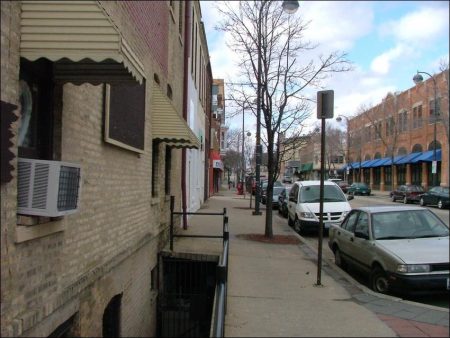Elgin (717 alt., 94,487 pop.) , an industrial town in the midst of wide farmlands, lies on the gentle bluffs of the Fox River. Although only an hour’s ride from Chicago, Elgin is sufficiently self-contained so that only 2 per cent of her wage earners commute to Chicago, and yet her industrial plants are not of the sort that cluster in an industrial wasteland.
A few blocks from Fountain Square–described by Elgin wits as a triangle without a fountain–rises the city’s major factory, while some of the finest houses are no greater distance down other radial streets. Concerned with more than industry, Elgin possesses an excellent art museum, a small zoo, and an extensive park system. “A midwest factory town,” remarked an anonymous Boston reporter, “is not the place where one would ordinarily look for such things.”
To Protestant ministers throughout the country, Elgin is the source of many of their Sunday School pamphlets; to Emerson Hough it is the city in which he wrote The Covered Wagon; to midwestern creameries it is the place their butter-tubs come from; but Elgin is known to the world at large as the manufacturer of the watches that bear the city’s name. The seven-story clock tower of the watch factory, visible for miles, rises high above the central section, and the factory with its related industries employs the major portion of the city’s workers.
The Black Hawk War was over when the first settlers, James and Hezekiah Gifford, came here from New York in 1835. An Indian ferried them over the Fox River on their way here, but by the following year northern Illinois was cleared of the red men, and the Giffords built up their little settlement without interference. Intent upon having the Chicago-Galena stage routed past his cabin, James Gifford laid out a road, with the assistance of Samuel Kimball, to Belvidere. “Anyone would think,” scoffed his wife, “that you expected this farm to become a city, with stagecoaches going through.” Within a year they were, twice weekly, with a great blare of horns.
Elgin’s industry from the first was bound to the river. Kimball and James Gifford co-operated again in 1837 in damming the river, and a sawmill was built on one side and a gristmill on the other. Hezekiah occupied himself running a tavern for the stagecoach passengers, who noted with “astonishment” that he ran it according to the newfangled temperance plan then gaining strength in the East.
In 1838 B. W. Raymond purchased a portion of Gifford’s tract and although he lived in Chicago and served as its third mayor, soon interested himself in the development of Elgin. Throughout the forties he invested in several local enterprises, and by 1847 Elgin was able to incorporate as a village. The following year Raymond, by pledging much of his property, had the Chicago and Galena Railroad routed into Elgin. For two years the village was the terminus of that road, and the great stream of west-bound pioneers here transferred to covered wagons. In 1854 Elgin was incorporated as a city.
Elgin began to ship milk to Chicago in 1852, and soon processed a growing surplus into cheese and butter. The city’s importance as a dairying center was greatly enhanced by Gail Borden. During his youth he had observed the difficulty encountered by Western travelers in transporting food and began experimenting with condensed foods. Following a stormy trans-Atlantic voyage, during which the ship’s cows refused to give milk, he concentrated on condensed milk, and soon had a successful plant running in Elgin. By 1875 it was using the milk from a thousand cows, and the product was being hawked from push-carts in New York and other metropolitan centers.
The watch industry came here in 1866, and by the application of new principles of manufacture soon rivaled dairying. Adopting much the same methods that Ford later used in the automobile industry, the Elgin plant standardized parts and introduced a modified assembly-line whereby craftsmen ceased to be watch-makers and became watchworkers. Low prices had widened the market, and the plant began to turn out thousands of watches monthly.The booming dairy trade resulted in the formation of a local Board of Trade, in 1872, and for forty years Elgin served as the Midwest marketing center.
The Board was an important factor in setting the national prices of butter and cheese; the Elgin Dairy Report bore the slogan “Elgin makes the price–We tell you what it is.” The peak year for cheese was 1883, when board members marketed 12,500,000 pounds; in 1911 they reached a high in butter sales with 57,000,000 pounds. During the World War I the Food Administration requested the Board to suspend operations, and after the Armistice it was not reorganized.
Visits: 112



